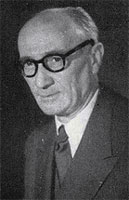
 André Thuret was born on November 3, 1898, in Paris. After completing his secondary studies, he enlisted in 1916 and was demobilized in 1919. He obtained his Bachelor's degrees in Science and Law and, from 1922, worked as an engineer at glassworks in Bagneux and Bezons.
André Thuret was born on November 3, 1898, in Paris. After completing his secondary studies, he enlisted in 1916 and was demobilized in 1919. He obtained his Bachelor's degrees in Science and Law and, from 1922, worked as an engineer at glassworks in Bagneux and Bezons.
As a result of his work, he participated in the 1925 Exposition des Arts Décoratifs and personally received a diploma of honor. Since 1926, he has been an assistant and then head of the Department of Applied Chemistry for Ceramic and Glass Industries at the Conservatoire National des Arts et Métiers. Additionally, he serves as an Expert for the Paris Court of Appeal. His activities, primarily focused on glass, encompass teaching, scientific research, and artistic production.
He exhibited at the Salon d'Automne in 1928 and 1932 and received his first award from the Société d'Encouragement à l'Art et à l'Industrie. In 1929-1930, he was invited to participate in the "Verres et Tapisseries" Exhibition in the United States. Since the Liberation, he regularly exhibited at the Salons des Artistes Décorateurs, d'Automne, and in various galleries. In 1951, he took part in the Glass Exhibition at the Pavillon de Marsan. Some of his pieces have been acquired by the State. André Thuret is a member of the Comité de la S.A.D., the U.A.M., and a Sociétaire of the Salon d'Automne. He was awarded the Chevalier de la Légion d'honneur in 1947.
An unusual case, André Thuret came to art through science. The engineer and chemist within him serve the artist and experimentally determine the various stages of his evolution. The scientist provides the fluid and transparent beauty of glass and the reactions of metal oxides to the creator of forms, rhythms, and colors. All of Thuret's vases, bowls, or flasks are unique pieces, blown and worked using traditional techniques at temperatures exceeding 1,000 degrees.
In his early days, André Thuret blew the "parison," a mass of fluid glass, into molds with raised decorations that were later colored by rolling them on marble charged with metal oxides. Around 1925, he created internal decorations enveloped in transparency through a new layer of glass.
From 1940 to 1950, he abandoned these decorations to focus on researching smooth forms. The initial pieces were white, and then the chemist intervened to add color. More recently, to achieve more subtle designs, manual sculptor-like processes have been employed.
Thuret always starts with the first transparent and fluid glass parison, which he blows into the desired shape. He also molds glass cords colored on the marble, fixing them according to preconceived rhythms. Then, he works and shapes them with iron and tongs before enclosing them in a final layer of smooth white glass.
This process results in pieces with external and internal transparencies, where rare tonalities, such as violet, blue, green, gray, and sometimes red, play within an originally independent life.
The art is as sophisticated as it is precise, despite the mysterious whimsy of its appearance.